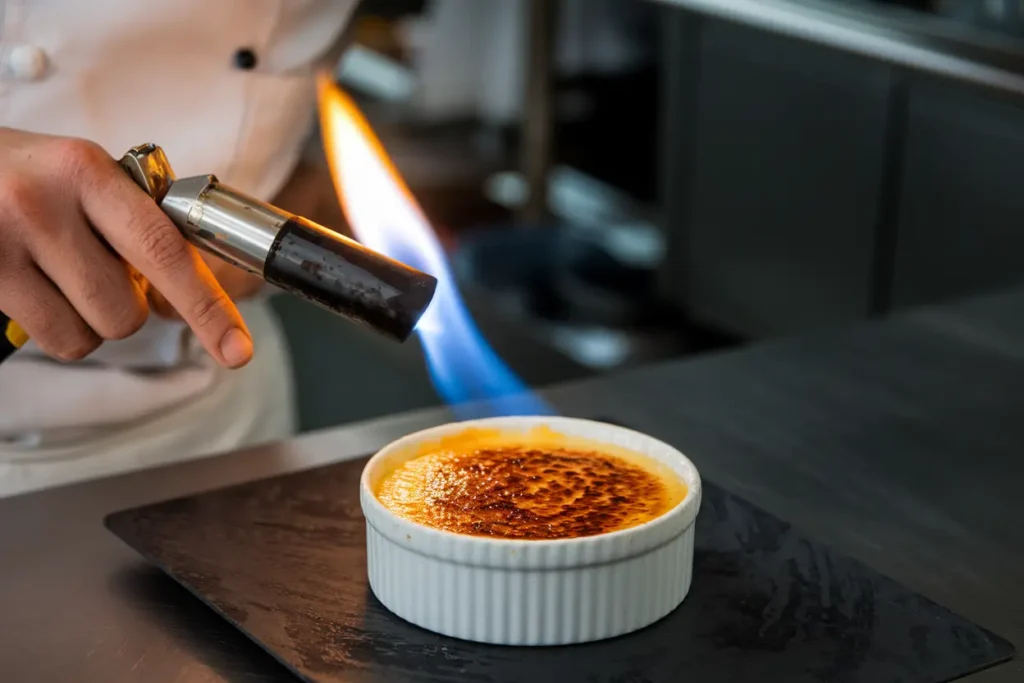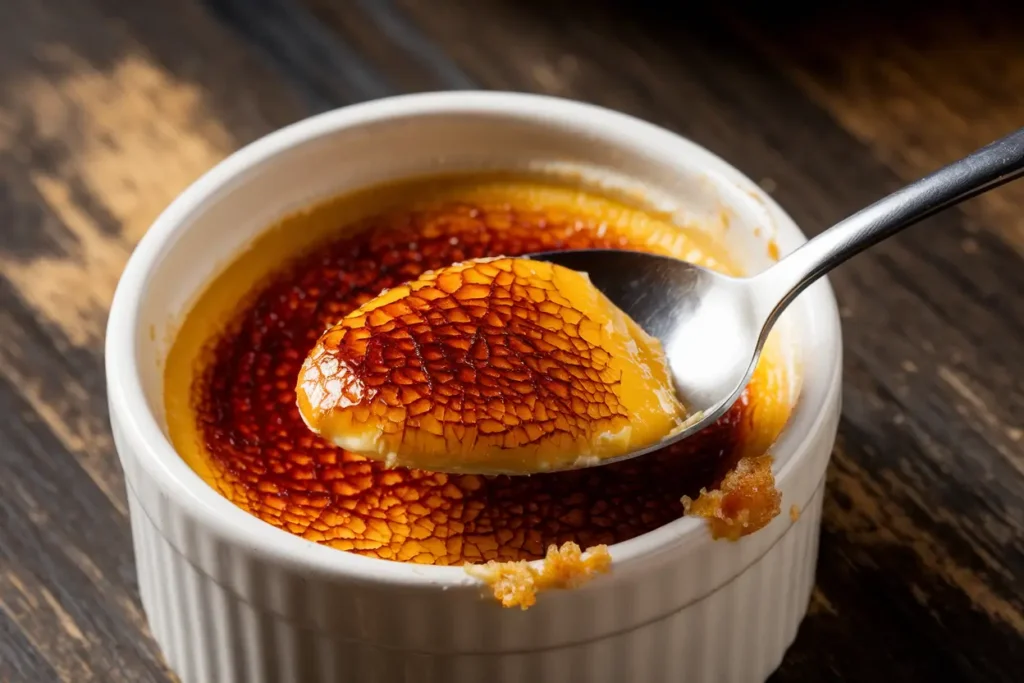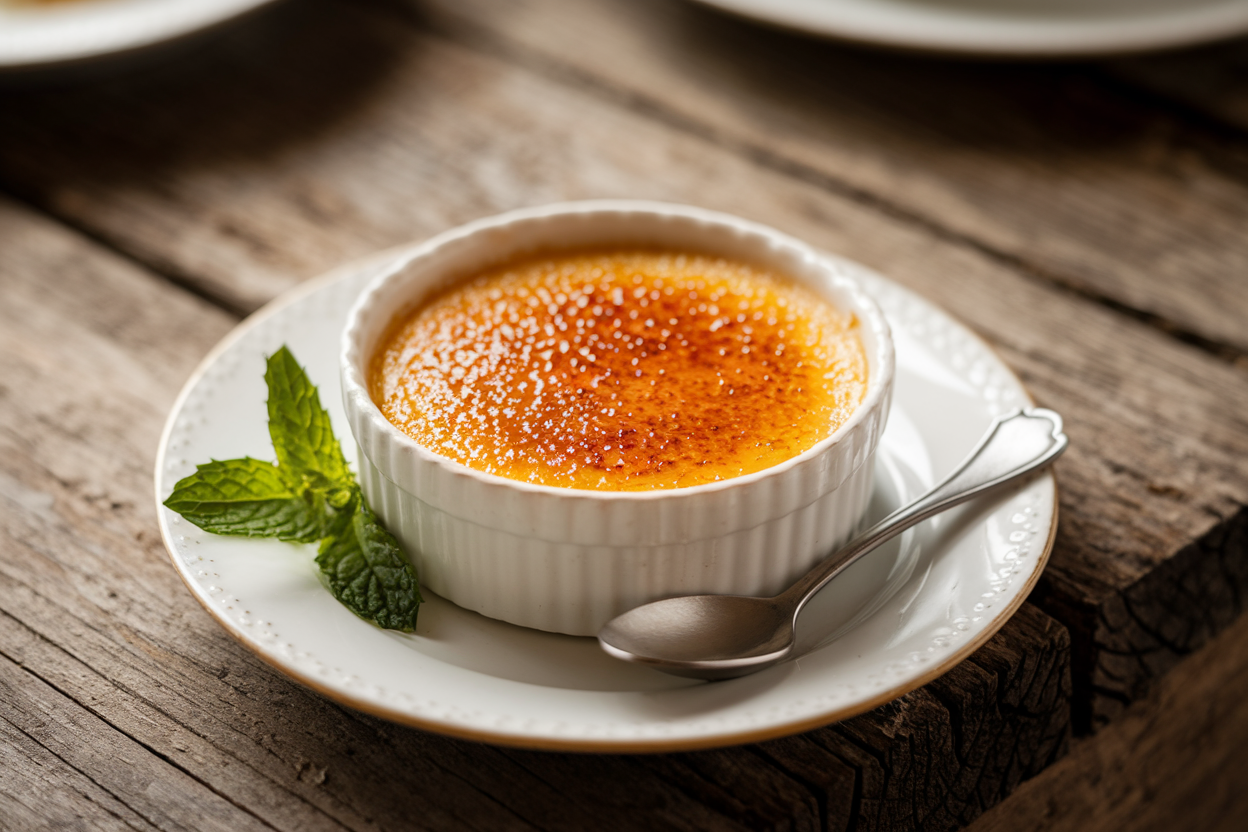Table of Contents
Introduction to Crème Brûlée
Crème brûlée is a dessert loved for its luxurious texture and flavor. But truly, what does Dessert crème brûlée taste like? This classic French dessert features a creamy vanilla custard base topped with a caramelized sugar crust. The combination is a delightful contrast of textures and flavors, blending rich sweetness with a touch of smoky caramel.
For those who haven’t tried it, the question “What does Dessert crème brûlée taste like?” might arise often. The answer lies in its simplicity: the custard is smooth, slightly sweet, and infused with the warmth of vanilla, while the crunchy top adds a burst of caramelized flavor.
Whether enjoyed in its traditional form or a variation like chocolate or fruit-infused versions, one thing remains clear: what does Dessert crème brûlée taste like? It tastes like a little piece of heaven in a ramekin. The balance of creamy custard and crackly sugar is an experience you won’t forget.
The Art of Making the Perfect Crème Brûlée
Mastering crème brûlée requires precision and patience. The secret to achieving a flawless custard lies in the technique. When whisking egg yolks and sugar, overmixing can create unwanted air bubbles, leading to an uneven texture. Slowly incorporating the warm cream ensures a silky consistency, while baking in a water bath prevents curdling and maintains the custard’s smoothness. The moment of truth comes with caramelizing the sugar—too little heat results in a grainy topping, while too much burns the sugar, creating bitterness. Achieving the perfect golden-brown crust is a delicate balance that rewards patience and skill.
The Origins of Dessert Crème Brûlée
A Brief History of the Dessert
Crème brûlée, French for “burnt cream,” traces its roots back to 17th-century Europe. The exact origin is a matter of debate, with France, Spain, and England all laying claim to the recipe.
- In France, it was introduced as a luxurious dessert served at royal banquets.
- Spain has its own variation called crema catalana, flavored with citrus and cinnamon.
- In England, it appeared as “Trinity Cream,” famously served at Trinity College, Cambridge, where the school’s crest was branded into the sugar topping.
How It Became a Global Favorite?
Crème brûlée gained widespread recognition in the late 20th century when chefs like Julia Child showcased its preparation on TV. Today, it’s a staple in fine dining restaurants, beloved for its simplicity and sophistication.

What Is Dessert Crème Brûlée?
Key Ingredients of Crème Brûlée
The charm of crème brûlée lies in its simplicity. It’s made with only a handful of ingredients:
- Heavy cream: The base that gives the custard its creamy texture.
- Egg yolks: Provide richness and stability to the custard.
- Sugar: Sweetens the custard and creates the caramelized crust.
- Vanilla: Adds a fragrant, warming aroma that defines its flavor profile.
The Role of Caramelization in Its Appeal
The pièce de résistance of crème brûlée is its caramelized top. This layer of hardened sugar contrasts beautifully with the soft custard beneath, offering a delightful textural interplay. The process of torching the sugar creates a rich, smoky-sweet flavor that complements the creamy custard.

How Is Dessert Crème Brûlée Made?
Traditional Recipe and Steps
Making crème brûlée at home requires patience and precision. Here’s step-by-step crème brûlée recipe:
- Prepare the custard: Whisk egg yolks and sugar, then slowly add warm heavy cream infused with vanilla.
- Bake gently: Pour the mixture into ramekins and bake in a water bath to ensure even cooking.
- Chill and set: Allow the custard to cool in the refrigerator for at least 4 hours.
- Torch the top: Sprinkle an even layer of sugar over the custard and use a kitchen torch to caramelize it.
Tip: Don’t have a torch? Use your oven’s broiler, but watch closely to avoid burning!
How to Get the Perfect Caramelized Sugar Crust
Achieving the perfect caramelized sugar topping is what makes crème brûlée so special. Many people ask, “How do you caramelize sugar on crème brûlée without a torch?” If you don’t have a kitchen torch, you can use your oven’s broiler setting. Simply sprinkle an even layer of sugar on top of the custard and place the ramekins under the broiler for 1-3 minutes, watching closely to prevent burning. For an even better result, chill the custard before caramelizing so the sugar melts smoothly without overheating the base.
Low-Sugar and Dairy-Free Alternatives for Crème Brûlée
If you’re looking for a healthier version of crème brûlée, there are several ways to adjust the recipe. Many people ask, “Can crème brûlée be made without dairy?” Yes! Substitute heavy cream with coconut cream or almond milk for a dairy-free alternative. To reduce sugar, swap white sugar for monk fruit sweetener or coconut sugar while still achieving a caramelized topping. These modifications allow people with dietary restrictions to enjoy the luxurious taste of crème brûlée without compromising on flavor.
Pro Tip: Don’t have a torch? Learn how to caramelize crème brûlée without a torch using an oven broiler.
Common Problems and Solutions When Making Dessert Crème Brûlée
While traditional vanilla crème brûlée is a classic, creative chefs have introduced exciting variations:
- Chocolate crème brûlée: Adds a rich cocoa twist.
- Fruit-infused flavors: Think raspberry, lemon, or passionfruit for a refreshing touch.
- Liqueur-infused custards: Grand Marnier or Bailey’s crème brûlée offers a boozy kick.

What Does Dessert Crème Brûlée Taste Like?
The Sweetness: Balancing Cream and Caramel
Crème brûlée’s flavor is a perfect harmony of sweetness and creaminess. The custard is delicately sweet, with the caramelized sugar crust adding a deeper, almost toffee-like sweetness.
Texture: A Play of Crunch and Creaminess
The textural contrast is a highlight. The top layer is crisp and satisfying to crack with a spoon, while the custard beneath is silky, almost melting on the tongue. It’s a dance of opposites that makes every bite exciting.
“Cracking the caramelized crust feels like opening a treasure chest of creamy goodness.”
Aroma: Vanilla and Beyond
The vanilla custard exudes a warm, inviting aroma that’s both comforting and luxurious. Additional flavors, like citrus or chocolate, can enhance this sensory experience, creating endless possibilities for enjoyment.
Why Is My Crème Brûlée Not Setting? Common Mistakes and Fixes
A frequent issue when making crème brûlée is a runny custard. Many beginners wonder, “Why is my crème brûlée not thickening?” The most common reasons include:
- Undercooking: Ensure the custard reaches an internal temperature of 170-175°F (77-80°C).
- Skipping the water bath: Baking in a water bath provides gentle heat and prevents curdling.
- Not chilling long enough: Crème brûlée needs at least 4 hours in the refrigerator to fully set.
By following these steps, you can achieve the perfect creamy texture every time.
Where to Find the Best Crème Brûlée Near You
If you’re wondering, “Where can I find the best crème brûlée near me?” many fine dining restaurants, French bakeries, and dessert cafés offer gourmet versions of this beloved treat. Popular locations include Michelin-starred restaurants, classic Parisian bistros, and even specialty dessert shops that experiment with unique crème brûlée flavors like matcha, lavender, and salted caramel. If you prefer homemade, searching for “best crème brûlée recipes” online will provide a variety of options to try in your own kitchen.
Popular Flavors and Variationsof Dessert Crème Brûlée
While the classic vanilla crème brûlée is timeless, culinary creativity has expanded its flavor profile into delightful variations. Let’s explore some of the most popular and unique takes on this beloved dessert.
Chocolate Crème Brûlée
For chocolate lovers, this variation is a dream come true. The addition of melted dark or milk chocolate to the custard base transforms the dessert into a rich, indulgent treat.
- Taste Profile: Creamy chocolate custard with a bittersweet edge, balanced by the caramelized top.
- Perfect Pairing: A dollop of whipped cream or a side of fresh berries.
Fruit-Infused Variations
Adding fruit flavors brings a refreshing twist to crème brûlée. Popular options include:
- Raspberry Crème Brûlée: Adds a tangy berry kick.
- Lemon Crème Brûlée: Offers a zesty brightness.
- Passionfruit Crème Brûlée: A tropical explosion of flavor.
Pro Tip: Use fruit purees or zests in the custard to infuse the flavors naturally.
Liqueur-Infused Custards
For an adult twist, liqueurs like Grand Marnier, Bailey’s, or Amaretto can be added. These variations bring warmth and depth to the dessert.
Common Problems and Solutions When Making Dessert Crème Brûlée
Even though crème brûlée is straightforward to make, some challenges can arise during preparation. Here are common issues and how to fix them.
Why Doesn’t the Sugar Caramelize Properly?
- Problem: The sugar remains grainy or doesn’t fully melt.
- Solution: Use superfine sugar for even melting, and ensure the torch or broiler is hot enough. Keep the flame moving to avoid burning one spot.
Avoiding a Runny Custard
- Problem: The custard is too soft or fails to set.
- Solution:
- Make sure to bake it in a water bath to prevent uneven cooking.
- Check that the custard reaches an internal temperature of 170°F.
- Refrigerate for at least 4 hours before serving.
Preventing Cracks in the Custard
- Problem: Cracks appear on the custard’s surface during baking.
- Solution: Bake at a low temperature (around 300°F) and avoid overcooking. Remove the ramekins from the oven as soon as the edges are set, but the center jiggles slightly.
Torching Mistakes
- Problem: The caramelized sugar burns or forms unevenly.
- Solution: Hold the torch a few inches away and move it in circular motions. Sprinkle the sugar evenly for a uniform crust.
“Don’t worry if your first attempt isn’t perfect—crème brûlée is as much about the process as it is about the final result!”
Serving Dessert Crème Brûlée
The presentation and pairing of crème brûlée can elevate the dining experience. Here’s how to serve it like a pro.
Ideal Pairings with Drinks and Other Desserts
- Beverages:
- Pair with a crisp white wine or sparkling champagne for a luxurious touch.
- Coffee or espresso complements the rich custard beautifully.
- Dessert Companions:
- Serve alongside a light fruit sorbet or a fresh fruit salad for balance.
- A biscotti or shortbread cookie adds a crunchy sidekick to the creamy custard.
Presentation Tips for an Elegant Dessert
- Use white ramekins to highlight the golden caramel crust.
- Garnish with a sprig of mint, a few berries, or a dusting of powdered sugar for a pop of color.
- For special occasions, write messages or designs on the crust with melted chocolate or edible gold flakes.
“Crème brûlée is not just a dessert—it’s an experience, from cracking the caramelized top to savoring the last creamy bite.”
Dessert Crème Brûlée in Popular Culture
This dessert’s charm extends beyond the dinner table, finding its way into movies, TV shows, and global cuisines.
Iconic Moments in Movies and Shows
Crème brûlée often symbolizes sophistication or romance in films. For example:
- In Amélie, crème brûlée is celebrated as part of the joy of simple pleasures, like cracking its caramel top.
- In various cooking shows, chefs use it to showcase their precision and skill.
Crème Brûlée Around the World
While rooted in French tradition, crème brûlée has inspired similar desserts worldwide:
- Crema Catalana: Spain’s citrus-infused version, often prepared for St. Joseph’s Day.
- Leche Quemada: A South American twist using condensed milk for a sweeter flavor.
- Japanese Matcha Crème Brûlée: Features green tea for a unique earthy taste.
Why Everyone Should Try Dessert Crème Brûlée?
Its Universal Appeal Across Taste Buds
Crème brûlée strikes a perfect balance of flavors and textures, making it a dessert that almost anyone can enjoy. Its versatility ensures there’s a version for every palate, whether you prefer classic vanilla or adventurous fruit flavors.
Perfect for Any Special Occasion
This dessert’s elegance makes it ideal for celebrations, romantic dinners, or even as a personal treat after a long day. Its preparation may require effort, but the reward is undoubtedly worth it.
“Crème brûlée is more than a dessert—it’s a little piece of heaven in a ramekin.”
Why Crème Brûlée Stands the Test of Time
Unlike trendy desserts that come and go, crème brûlée has remained a beloved classic for centuries. Its timeless appeal lies in its simplicity—just a handful of ingredients come together to create something extraordinary. The balance of flavors, the elegance of presentation, and the satisfaction of cracking into that caramelized top all contribute to its enduring popularity. Whether enjoyed in a Michelin-starred restaurant or made at home for a cozy night in, crème brûlée continues to captivate dessert lovers across generations.
Conclusion: The Magic of Dessert Crème Brûlée
Crème brûlée is a dessert that has stood the test of time, cherished for its simplicity and sophistication. From its creamy vanilla custard to its caramelized top, it offers a sensory experience that’s hard to match. Whether you’re enjoying the classic recipe or a modern variation, crème brûlée is a dessert that always leaves an impression.
So, the next time someone asks, “What does crème brûlée taste like?” you’ll not only have the answer but a newfound appreciation for this culinary masterpiece. 😊
For more Recipe can you clic here: https://cheifrecipes.com/baked-beans-recipe-comfort-food-youll-crave/


1 thought on “What does crème brûlée taste like?”